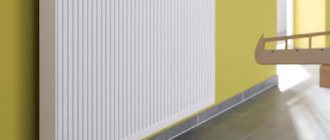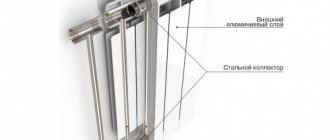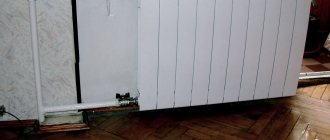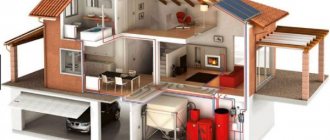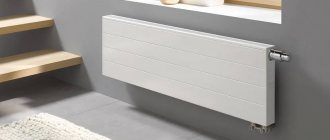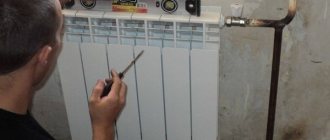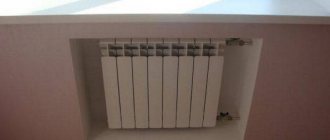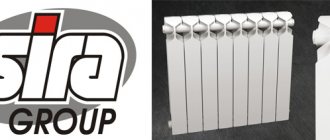If there are no sections, we take the total power of the device.
Important! It should be taken into account that the specification data are indicated for ideal conditions when the coolant is supplied at normal temperature and pressure. For real conditions, it is recommended to make an adjustment of 15–20% upward.
Calculation of the number of sections of heating radiators by area calculator. Selection of heating power
When selecting a heating scheme for a small private house, it is this indicator that is decisive.
To calculate sections of bimetallic heating radiators by area, you need to determine the following parameters:
- the amount of necessary compensation for heat losses;
- total area of the heated room.
In construction practice, it is customary to use the first indicator in the given form as 1 kW of power per 10 square meters, i.e. 100 W/m2. Thus, the ratio for calculation will be the following expression:
N = S x 100 x 1.45,
where S is the total area of the heated room, 1.45 is the coefficient of possible heat loss.
If we look at a specific example of calculating the heating power for a room of 4x5 meters, it will look like this:
- 5 x 4 = 20 (m2);
A typical place to install a radiator is under a window, so we use two radiators of the same power of 1450 W. This indicator can be influenced by adding or reducing the number of sections installed in the battery. It should be taken into account that the power of one of them is:
- for bimetallic ones with a height of 50 centimeters - 180 watts;
- for cast iron radiators – 130 watts.
Therefore, you will need to install: bimetallic – 1450: 180 = 8 x2 = 16 sections; cast iron: 1450: 130 = 11.
When using glass bags, heat loss on windows can be reduced by approximately 25%.
Calculation of sections of bimetallic heating radiators by area gives a clear initial idea of their required quantity.
Dependence of the degree of heat transfer on the connection method
The heat transfer of heating radiators is affected not only by the material of manufacture and the temperature of the coolant circulating through the pipes, but also by the chosen option for connecting the device to the system:
- The connection is direct one way
. It is the most favorable in relation to the thermal power indicator. For this reason, the calculation of the heat transfer of a heating radiator is performed precisely with a direct connection. - Diagonal connection
. It is used if you plan to connect a radiator to the system in which the number of sections exceeds 12. This method allows you to minimize heat loss. - Bottom connection
. It is used when the battery is connected to a floor screed in which the heating system is hidden. As the calculation of the heat transfer of the radiator shows, with such a connection, the loss of thermal energy does not exceed 10%. - Single pipe connection
. The least profitable method in terms of thermal power. Heat transfer losses with a single-pipe connection most often reach 25 - 45%.
Aluminum heating radiators, calculation of the number of sections. Simple calculation
Table for calculating the required number of sections depending on the area of the heated room and the power of one section.
Calculating the number of sections of heating batteries using a calculator gives good results. Let's give a simple example for heating a room of 10 square meters. m - if the room is not corner and has double glazed windows, the required thermal power will be 1000 W. If we want to install aluminum batteries with a heat dissipation of 180 W, we will need 6 sections - we simply divide the resulting power by the heat dissipation of one section.
Accordingly, if you buy radiators with a heat output of one section of 200 W, then the number of sections will be 5 pieces. Will the room have high ceilings up to 3.5 m? Then the number of sections will increase to 6 pieces. Does the room have two external walls (corner room)? In this case, you need to add another section.
You also need to take into account the thermal power reserve in case of a too cold winter - it is 10-20% of the calculated one.
You can find out information about the heat transfer of batteries from their passport data. For example, the number of sections of aluminum heating radiators is calculated based on the heat transfer of one section. The same applies to bimetallic radiators (and cast iron ones, although they are not removable). When using steel radiators, the rated power of the entire device is taken (we gave examples above).
Radiator heat transfer: what does this indicator mean?
The term heat transfer means the amount of heat that a heating battery transfers to a room over a certain period of time. There are several synonyms for this indicator: heat flow; thermal power, device power. The heat output of heating radiators is measured in Watts (W). Sometimes in the technical literature you can find a definition of this indicator in calories per hour, with 1 W = 859.8 cal/h.
Heat transfer from radiators occurs through three processes:
- heat transfer;
- convection;
- radiation (radiation).
Each heating device uses all three heat transfer options, but their ratio differs for different models. Previously, it was customary to call radiators devices in which at least 25% of the thermal energy is released as a result of direct radiation, but now the meaning of this term has expanded significantly. Nowadays, convector-type devices are often called this.
Calculation of heating radiators in a private house. Calculation of the number of radiators in a private house
If for apartments it is possible to take the average parameters of heat consumption, since they are designed for standard room dimensions, then in private construction this is incorrect. After all, many owners build their houses with ceiling heights exceeding 2.8 meters, in addition, almost all private premises are corner, so heating them will require more power. In this case, calculations based on the area of the room are not suitable: you need apply the formula taking into account the volume of the room and make adjustments by applying coefficients for reducing or increasing heat transfer. The values of the coefficients are as follows:
- 0.2 - the resulting final power number is multiplied by this indicator if multi-chamber plastic double-glazed windows are installed in the house.
- 1.15 – if the boiler installed in the house operates at its capacity limit. In this case, every 10 degrees of heated coolant reduces the power of the radiators by 15%.
- 1.8 is the magnification factor that needs to be applied if the room is corner and has more than one window.
To calculate the power of radiators in a private house, the following formula is used:
P = V x 41, where
- V – volume of the room;
- 41 – average power required to heat 1 sq. m of a private house.
Calculation example If you have a room of 20 sq. m (4x5 m - the length of the walls) with a ceiling height of 3 meters, then its volume is easy to calculate: 20 x 3 = 60 W. The resulting value is multiplied by the power accepted by the standards: 60 x 41 = 2460 W - this is how much heat is required to heat the area in question. Calculation of the number of radiators comes down to the following (taking into account that one radiator section emits 160 W on average, and their exact data depends on the material from which the batteries are made): 2460 / 160 = 15.4 pieces. Let's assume that a total of 16 sections are needed, then There is a need to purchase 4 radiators of 4 sections for each wall or 2 of 8 sections. At the same time, one should not forget about the adjustment coefficients.
Heat dissipation of batteries made of different materials
When choosing a heating radiator, you should remember that they differ in the level of heat transfer. The purchase of batteries for a house or apartment should be preceded by a careful study of the characteristics of each model. Often devices that are similar in shape and size have different heat output.
Cast iron radiators
. These products have a small heat transfer surface and are characterized by insignificant thermal conductivity of the manufacturing material. The rated power of a section of a cast iron radiator, such as MS-140, at a coolant temperature of 90°C is approximately 180 W, but these figures were obtained in laboratory conditions (for more details: “What is the thermal power of cast iron heating radiators”). Heat transfer is mainly carried out due to radiation, and convection accounts for only 20%.
In centralized heating systems, the coolant temperature usually does not exceed 80 degrees, and in addition, part of the heat is consumed when hot water moves to the battery. As a result, the temperature on the surface of the cast iron radiator is about 60°C, and the heat transfer of each section is no more than 50-60 W.
Steel radiators
. They combine the positive characteristics of sectional and convection devices. They consist, as can be seen in the photo, of one or several panels in which the coolant moves inside. To increase the heat transfer of steel panel radiators, special fins are welded to the panels to increase power, functioning as a convector.
Unfortunately, the heat transfer of steel radiators is not very different from the heat transfer of cast iron radiators. Therefore, their advantage lies only in relatively light weight and more attractive appearance.
Consumers should be aware that the heat transfer of steel heating radiators is significantly reduced if the coolant temperature decreases. For this reason, if water heated to 60-70°C circulates in the heating system, the indicators of this parameter may differ greatly from the data provided for this model by the manufacturer.
Aluminum radiators
. Their heat transfer is much higher than that of steel and cast iron products. One section has a thermal power of up to 200 W, but these batteries have a feature that limits their use. It serves as a coolant. The fact is that when contaminated water is used from the inside, the surface of the aluminum radiator is subject to corrosive processes. Therefore, even with excellent power indicators, batteries made of this material should be installed in private households where an individual heating system is used.
Bimetallic radiators
. These products are in no way inferior to aluminum devices in terms of heat transfer. The heat flow of bimetallic products is on average 200 W, but they are not so demanding on the quality of the coolant. True, their high price does not allow many consumers to install these devices.
Ways to increase heat transfer
There are several ways to increase the heat transfer of heating devices:
- Regular wet cleaning to clean the surface of the batteries. The cleaner they are, the higher their level of heat transfer.
- Equally important is the correct painting of the radiator, especially for cast iron appliances. The fact is that multi-layer applied paint prevents effective heat transfer. Before you start painting the heating radiator, you should remove the old layer. No less effective is the use of special enamels intended for pipelines and heating devices, since they have low resistance to heat transfer.
- To ensure maximum power, these devices must be installed correctly.
- Among the main mistakes made during installation, experts note: – tilting the battery; – installing the device too close to the floor or wall; – blocking access to radiators with furnishings and installing inappropriate reflective screens.
- To increase the efficiency of heating batteries, it would not hurt to inspect their internal cavity. Often, in the process of connecting heating radiators to the system, burrs are formed, due to which, during operation, blockages are formed that prevent the free movement of the coolant.
- You can place a heat-reflecting screen made of foil material on the wall behind the heating device.
